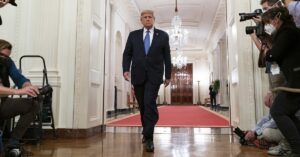New York Times photographer wins Pulitzer Prize for dramatic Trump rally photo
Doug Mills, a seasoned photographer from the New York Times, captured a dramatic moment during an attempted assassination of President Donald Trump, earning him the Pulitzer Prize.
On July 13, during a rally in Butler, Pennsylvania, Mills took an extraordinary photograph of a bullet zipping past President Trump's head, a moment that would become iconic in the annals of political photography.
On the day of the rally, Mills was positioned under a massive flag, just feet away from President Trump. As the president addressed the crowd, stands filled with supporters watched eagerly. The atmosphere, filled with anticipation, transformed abruptly with the sound of gunfire.
In an electrifying instant, Mills instinctively continued capturing images. As chaos ensued, President Trump instinctively reached for his ear, grimacing with the realization of danger. "He grimaced and grabbed his hand," Mills later recounted, describing the chilling moment he sensed the potential gravity of the situation.
Iconic image discovered by chance
The urgency of the attack left Secret Service agents swiftly escorting Trump from the stage, even as he defied panic by shouting, "Fight, fight, fight." This unexpected display of bravado underscored the dramatic scene unfolding in real-time.
The subsequent scramble of media professionals captured the frenzy that followed. Mills, amid the intensity, was unaware at the moment of the remarkable image stored in his camera. Reflecting on the event days later, the magnitude of what he captured began to surface.
At the Republican National Convention in Milwaukee, Mills shared the surreal experience with Fox News. "I just happened to be shooting with a wide-angle lens," he recalled. The realization came during the meticulous review of the photos, where Mills discovered the breathtaking capture that seemed to hold time still.
The photo that shaped a legacy
Upon sending the initial batch of images to his editor, Doug Mills had an inkling about the photograph's importance. His instincts were confirmed when the editor exclaimed, "You won't believe this," highlighting the visible bullet as a striking detail amidst the chaos.
This photograph, embodying a moment frozen in time, symbolized not just a potentially tragic event but the unpredictable spirit of photojournalism that transforms ordinary shots into historical records. "I started sending them right away," Mills noted, emphasizing the urgency in communicating this visual narrative.
The New York Times media reporter, Katie Robertson, celebrated Mills' achievement, recognizing his poignant image as part of the esteemed newspaper's collection of Pulitzer Prize-winning works. The Times also received accolades for reporting on stories from Sudan, Afghanistan, and Baltimore, highlighting the organization’s continued excellence in journalism.
Behind the lens: a photographer's experience
Mills’ use of the Sony a1 camera, with its capability to capture high-speed events, played a crucial role. The advanced technology allowed him to document the assassination attempt with clarity and precision that would define the image's iconic status.
Looking back, Mills described sorting through his photos, almost reliving the moments. "I remembered taking pictures of him," he remarked, casting his mind back to the urgency interwoven with his duty as a photographer at the rally.
In the wake of the attempt on Trump's life, the photos became more than mere images; they were a testament to the event’s magnitude, preserving an indelible moment in history. This particular photograph, along with Mills’ others from that day, has cemented his status as a distinguished photojournalist.
The story, while deeply tied to the events of the rally, transcends them. It’s a testament to the power of visual storytelling, where one frame tells a story as profound as any written word, capturing the raw emotion and urgency of those seconds.
As Mills looks ahead, armed with recognition and praise, the experience serves as a poignant reminder of the risks and rewards inherent in the pursuit of truth through a lens. His work continues to exemplify the core of journalism, emphasizing the delicate balance between the observer and the observed, resulting in a story that resonates with audiences worldwide.




